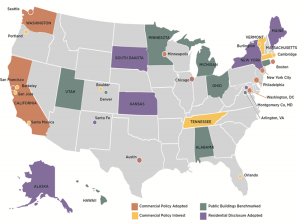Smart consumers know that they need to read “the fine print” before making a major purchase, to ensure they aren’t saddled with any extra costs. However, a lack of transparency with respect to the energy performance of large buildings makes it difficult to know which buildings are going to cost you more to operate. Furthermore, large-building owners who have invested in energy performance improvements aren’t necessarily rewarded in the marketplace, because consumers can’t see and compare building operation costs. This state of affairs is bad for consumers, and bad for the climate.

Mandatory energy reporting and benchmarking for large buildings is globally recognized as a key policy tool for reducing greenhouse gas (GHG) emissions. It’s especially important in cities, where energy use in buildings typically accounts for 40%–60% of total emissions (48% in Toronto in 2012). A growing number of jurisdictions are adopting reporting and benchmarking requirements for commercial and/or multi-residential buildings. Washington, D.C., and New York City were the first major cities to pass such policies in North America, followed swiftly by San Francisco, Seattle, Philadelphia, Chicago and others.
Recognizing the growing consensus on the effectiveness of energy benchmarking policies, TAF published a background report exploring the potential benefits of such a policy for Toronto and made this topic the focus of our Dan Leckie Forum in 2014. At that event, we convened stakeholders from the real-estate sector, utilities, academia, and all three levels of government to consider the pros and cons of this approach. Based on the positive response at the Forum, TAF worked with City of Toronto colleagues and councillors to bring the matter before City Council for consideration. As a result, City Council adopted a motion supporting development of a mandatory benchmarking policy for Council’s final consideration in 2015. So, where are we at now?
The City started by commissioning a study to verify the social, economic and environmental benefits of a city-wide energy reporting and benchmarking bylaw. The proposed bylaw would require all large commercial and multi-residential buildings to report annual energy and water use to the City, which would make the information available in a public database (municipal and public-sector buildings would be excluded as they are already subject to a similar provincial benchmarking regulation). Looking over a 20-year horizon, the study found potential for cumulative benefits of up to 6 million tonnes of avoided GHG emissions, up to $3.4B in energy savings, and up to 18,000 person years of employment. On the strength of this positive impact potential, TAF has approved a multi-year grant to the City to help offset the program’s initial start-up costs, should the bylaw be adopted by City Council.
As I write this, the City, supported by a consulting team at Integral Group, is consulting with stakeholders likely to be affected by the proposed bylaw. The Province of Ontario, which is considering implementing a similar regulation province-wide, is co-sponsoring the consultation process. A Best Practices Summit will be held on March 24, 2015, where industry leaders will share their insights based on experience with reporting and benchmarking programs in other jurisdictions. Consultation workshops will be held in Toronto on April 8 and 9, providing an opportunity for stakeholders to give detailed input on policy design and implementation.
A bylaw and implementation plan, informed by the consultation process, is expected to be brought to the City’s Parks and Environment Committee for a recommendation to Council in June 2015. If the Province opts to implement a similar regulation province-wide, a City bylaw may be redundant, or may be more narrowly focused on gaps.
One way or another, mandatory energy reporting and benchmarking appears to be in the cards for Toronto’s buildings. This will help support consumer choices, build value for efficient buildings and generate significant greenhouse gas reductions. It will also create unprecedented clarity on where and how energy is used across the City, helping unlock the next generation of innovative climate change solutions.

